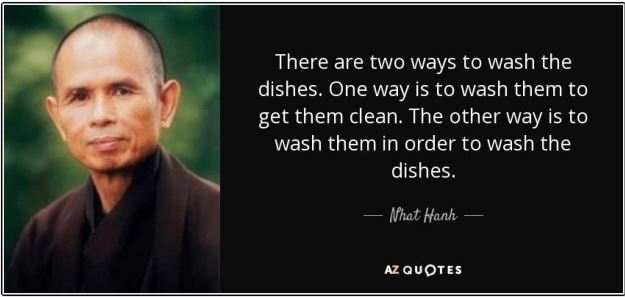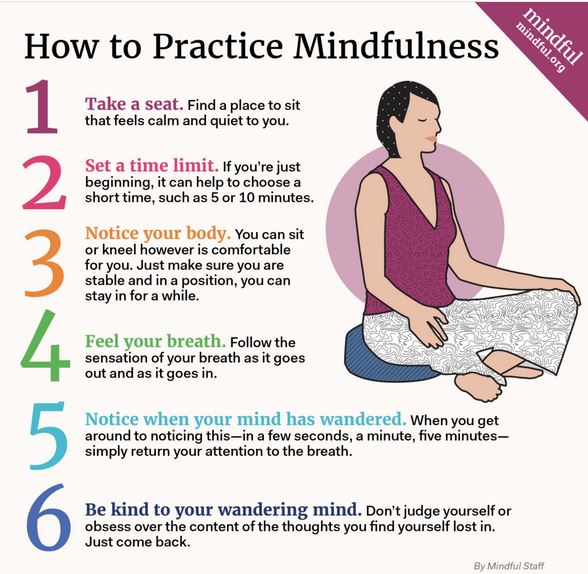How To Practise Mindfulness
Drop The Cushion, Focus Your Mind On NOW
Be Humble And Just Do This Simple Thing
Why learn How To Practise Mindfulness?
Learning how to practise mindfulness is valuable because the practise of mindfulness is a powerful life skill that will reduce your stress and increase your ability to think effectively.
Specifically, it is a practise that enables you:
- To be aware of your body and what it is feeling
- To be fully present and engaged with the tasks and activities you are engaged in.
- To observe the endless repetitive cycles of your thoughts and feelings
- To notice how you become so immersed and totally identified with these thoughts and feelings
- To learn how to stop thinking and enjoy an inner space and peace - whenever you choose to do so
Mindfulness is a natural state. We all have the capacity to be mindful.
The purpose of learning how to practise mindfulness is to develop the skill to do it "on demand" - or to put it technically developing an unconscious competence.
Learning how to practise mindfulness is basically learning a series of
structured mental disciplines and habits that takes your natural and innate ability to be mindful and trains your mind to bring this under your conscious control .
Basic Mindfulness Meditation Technique
Keeping It Real
Before you read any more on this page, I recommend that you quickly read through these short pieces of about 500 words each as they will provide context and background to the material on this page and the related pages on the theme of "How To Change Your Life".
The Best Way To Learn How To Practise Mindfulness
One of the best ways to get started with mindfulness is to take advantage of the many daily opportunities for practising mindfulness in the simple everyday tasks and activities that we normally do on "auto-pilot".
We have already established that mindfulness is a natural state so let's put it into practise with a routine task such as washing the dishes, or putting the trash out and follow these simple steps.
The Problem With Joining A Meditation Group Or Any Formal Practise
Don't get me wrong, of course it's a good idea to take time each day to sit comfortably and focus on your breath and observe your thoughts and emotions as they arise.
But, this is a very secondary activity to actually just doing it!
The sitting on a cushion or joining a practise works better for you as a support and reinforcement rather than as an end itself.
One of the disadvantages of joining a mindfulness meditation group or establishing a daily practice of sitting on a cushion focusing on your breath is that your inner narrative that accompanies these activities becomes:
"...look at me doing mindfulness and being mindful..."
and then there is the social side of joining a group and with it comes a social identity:
"...I am a mindfulness meditator I belong to X practise group..."
Join A Meditation Group But Beware Of This: What tends to happen is that the
practise of mindfulness becomes compartmentalised to the day and time
that you go and join with the group or go sit on our cushion. You become like those people who
put on their best clothes on Sunday and go to church, but for the rest
of the week, their religion makes zero difference to how they live their
life. Mindfulness is a daily practice in every area of your life. It is not an identity, it is not about doing, it is about being.
Despite its origins in the Buddhist meditation practises of Zazen and Vipasana the practise of mindfulness does not require you to affiliate with any faith tradition or belief system.
Mindfulness practise is actually a very simple and straightforward thing to do.
And here's the rub:
It is because the practise of mindfulness is such a simple, straightforward and natural thing to do, you make it so complicated.
Why? Because your ego resists:
- Your ego wants to read a book on mindfulness
- Your ego needs to understand mindfulness
- Your ego wants to be informed about mindfulness
- Above all, your ego wants to take on the identity of mindfulness
There are a wide range of ways of practising mindfulness and I will share some of these mindfulness exercises with you, but the key thing I want you to take on board is to just do it - and keep doing it!
Your mind (and your ego) will resist and you will want to become more informed about it and will want to read yet another book on mindfulness.
And yet, this is precisely the time for you to apply the simple mindfulness meditation training of persistent and consistent practise.
The human mind loves to make this simple thing so complicated - yet mindfulness is called a PRACTISE for a good reason!
You mind will get bored and want to be entertained, distracted and engaged. That's what minds do, and that's why they are sometimes referred to as "monkey minds".
Basic Mindfulness Meditation Technique
If you want some further pointers, you can download:
6 Practices Based On The Work Of Eckhart Tolle
Or read this:
Thich Nhat Hanh teaches five simple exercises to help you live with joy.
How To Practise Mindfulness - Key Themes
Basic Mindfulness Meditation Technique
Getting the hang of the basics of mindfulness meditation technique is fundamentally very simple. As we discussed in the story of the leper and the dirty river the hardest aspect of how to practise mindfulness is just doing it! Getting the hang of the basics of any new skill takes approximately 3 weeks or so of continuous conscious effort at which point the new skill becomes a habit. So this is really all it takes to master the basics of mindfulness meditation technique.
How To Trust The Process Of Mindfulness - Right Now
When we talk about how to trust the process of mindfulness the credibility of the process is heavily dependent on the first-hand experience of people who have already trodden this path before us. In this short article we are going to draw from their experience in a series of simple practices and reflections. Here are some simple practical steps to help you trust the process of mindfulness.
Mindfulness - as a natural state
Mindfulness is a natural state that occurs spontaneously, when we are unaffected by our thoughts and where we are totally present. The practise of mindfulness is simply a series of structured mental disciplines and habits that take those natural and spontaneous occurrences of present moment awareness and brings them under conscious control and in so doing it makes that freedom more possible, more frequent and eventually available whenever we need it.
Practising mindfulness in daily life
There are many daily opportunities for practising mindfulness in the
simple everyday tasks and activities that we normally do on
"auto-pilot". These are excellent further opportunities to learn how to practise mindfulness. Here's what to do...
The
most important exercises are what I call "integration practise",
applying mindfulness into specific situations and states of mind occurring in
daily life. This is where the mindfulness rubber hits the road of real-life...
Mindful listening is active listening. Mindful listening is when you are hearing beyond the spoken words to their essence, and you are not mentally processing and working out what you are going to say next. The dynamics of active listening differ from "normal" listening in several important respects…
Guided Mindfulness Meditation is designed to help you deepen your practise. It is focused on drawing your attention into a mindful practise or to reflections on various insights and teachings.
My experience of mindfulness in a situation of imposed change is illustrated by the story about a king who sought wisdom and summoned the wise man to
counsel him...The wise man said to the king:
"Regardless of whether you are experiencing good fortune or adversity
remind yourself that this too will pass…." I also learned 3 other ways of applying mindfulness to cope with imposed change.
Zen enlightenment - the end of delusion?
Zen Enlightenment – is being free of the effects of the mind. Being stuck in seeking it is the single biggest stumbling block to experiencing it now. There is nothing of truth that we can find anywhere but NOW right here in this present moment.
A zen based process that allows for a shift of perspective on demand and creates the opportunity for a facilitated view of the transcendent. In summary:
- Becoming unstuck and seeing other perspectives
- Recognising and owning disowned voices (or parts of our self)
- Becoming aware of and owning voices/parts of ourself we didn't know existed
- Accessing and owning the "enlightened state"
The key to effective self dialogue is to have tools, techniques and resources that work with all levels of your mind.
This simple self-facilitated technique enables you to do two things:
- To access your unconscious and "hard to reach" parts to enable you to break and change habits and to overcome your inner resistance to personal change.
- To access, experience and communicate directly with your higher or
transcendent self to give you the power to actually follow through and make these changes and have them stick.
Mind Games
Here is how to free yourself from your mind's games. Don't give 100 percent of your attention to the external world and to your mind. Keep some within. 6 practical tips based on my experiences.
Discover the joy of a quiet mind. Cherish the times when you are not thinking about anything. Imagine being able to create a space in your head where there are no thoughts and no emotions... just space and awareness of the sounds and smells and visual images around you...awareness of the sensation of your breath entering and leaving your body. It's not easy. But it is possible. Hear is how.
There are hardware & software reasons why we think the way we do, and these highlight the need for a balanced brain. When we engage with meditation practises, we are re-shaping or re-programming the physical neurological connections between the left and right lobes of our brains via the corpus-callosum to achieve the lived experience of a physiologically better balanced brain!
Being stuck in seeking is the single biggest stumbling block to present moment awareness.It is often the most sincere, the most devout, the most dedicated who are the most stuck in seeking – in many cases almost as a badge of honour – seeking truth, seeking God, seeking enlightenment, seeking nirvana, seeking deeper understanding and growth. There is nothing of truth that we can find anywhere but now right here in this present moment.
The Wise Advocate - Helping You Achieve The Very Best Outcome
The Wise Advocate is the voice within you that can help you make the best decisions about all the things you care about: your relationships, family, community, workplace, in fact any significant area of your life. The Wise Advocate is the focal point of all the hundreds of articles I have written and posted on this site over the past 10 years, this is where thinking skills and the practice of mindfulness all come together. I feel that is the most important and practical subject I have written about to date. This one really is a life changer!
Recommended Further Reading - With Action Points:
- Why You Need To Be Intimate With Your Own Thinking
- Rewiring Your Autopilot – How To Harness Your Subconscious Mind
- Universal Awareness and the Machinery of Thought
- How to See Your Thoughts Without Becoming the Story
Reflections and Action Points
Reflections
- The article says mindfulness helps you “be aware of your body and what it is feeling” and “be fully present and engaged with the tasks and activities you are engaged in.”
- When during your day do you most notice that you are not fully present or aware of your body? What physical sensations tend to go unnoticed until they become discomfort or pain? What would “being fully present” feel like for you in one routine activity you do every day?
- It points out that mindfulness is a “natural state” and that the challenge is training your mind to bring that state under conscious control.
- What assumptions do you hold about mindfulness being “hard”, “mystical”, or “for someone else”?
- How might your inner voice (“ego” in the article’s words) resist just doing something simple? (The article names: reading a book, identifying with being a mindfulness person, etc.) What might shift if you dropped the “identity of a mindfulness person” and simply practiced being present?
- The article emphasises that while formal sitting meditation has value, the “real” opportunity is bringing mindfulness into everyday tasks (washing dishes, driving, etc.).
- Which “everyday tasks” in your life tend to happen on autopilot? Which of those could you choose as a deliberate mindfulness-practice opportunity? What obstacles (time, mindset, environment) might stop you from doing so?
- There is a story of Naaman immersing himself in a muddy river rather than a clean one, used as a metaphor for humility and simply doing the practice.
- In what areas of your life do you expect “the perfect conditions” for change rather than just starting where you are? How might you practise humility in your mindfulness efforts — accepting “imperfect” moments, or “muddy waters” of distraction and mind-wandering?
- The article warns about becoming “stuck in seeking” (always looking for the next book, the deeper experience, the identity) rather than simply practising.
- When have you noticed yourself doing that: seeking rather than practising? How could you shift your focus from “learning about mindfulness” to “doing mindfulness”?
Action Points
Here are actions you can take now (and over the next few weeks) to integrate the article’s guidance into your life.
Choose one everyday activity this week for your mindfulness experiment.
- Pick something you already do daily (e.g., making coffee/tea, walking to/from your car, washing up).
- Commit for one week to perform that activity once with full presence: notice your body, senses, thoughts, and any interruptions.
- After you finish, take a 1-minute pause to ask: “What did I notice? What was different compared to doing it on autopilot?”
Set a brief “daily 3-minute presence” check-in.
- At a consistent time (e.g., after lunch or before going to bed), pause for 3 minutes.
- In those 3 minutes: close your eyes (if safe), feel your body, focus on your breath, note any dominant thoughts, and simply return your focus to the “now” when you notice the mind has wandered.
Track your “mind autopilot moments.”
- Keep a small note (on phone or paper) for a week: record 1-2 times when you realised you were on autopilot (doing something without noticing) and what triggered it.
- At week’s end, review and pick one trigger or context (e.g., tiredness, distraction, multitasking) and plan a small adaptation to interrupt that autopilot (e.g., a reminder, slower pace, one breath before starting).
Observe your inner narrative about mindfulness.
- Notice the thoughts: “I’m not good at this”, “I should be more advanced”, “I’ll do it when I have more time”, “I want to belong to a meditation group”.
- When these thoughts arise, label them (e.g., “thinking about mindfulness”) and then redirect attention to “just doing” — for example, “Now I’ll do the 3-minute practice” or “Now I will be present in dish-washing”.
Plan for 3-weeks of consistent practise.
- The article notes that the “basics … take approximately 3 weeks of continuous conscious effort at which point the new skill becomes a habit.”
- Set a simple target: e.g., 5 minutes per day of mindful presence (in a chosen activity) for 21 days.
- At Day 21, reflect: What’s changed? What feels more automatic? Where are you still resisting?
Integrate mindfulness into one “imposed change” or discomfort situation.
- Think of a current stressful or uncomfortable situation (e.g., slow traffic, congestion, waiting rooms — something you mentioned interest in).
- Before the situation happens, plan: “In the slow-traffic moment I will notice my body, bring attention to breath, note the mental narrative (‘this is wasting time’), and then shift my focus to the present moment.”
- After the event, reflect: “What was different when I used mindfulness? What still pulled me into autopilot or frustration?”
Further Resources For Students
StudyCorgi provide a range of practical mindfulness resources specifically targeted at students which are simply explained and well illustrated with helpful graphics. There are also links to a range of useful third party articles.
I have no commercial connection whatsover with StudiCorgi and I am featuring their resources simply because I feel this material could be of considerable benefit to students.
These mindfulness resources are free.
8 Mindfulness Practices & 5-Minute Recharging Activities for Students
Return from "How To Practise Mindfulness" to Home Page
LATEST ARTICLES
The Battle For Your Mind - How To Win Inner Freedom In A Digital Age Of Distraction
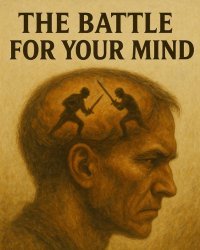 From External Events to Inner Events. We often think of “events” as things that happen out there: the traffic jam, the rude comment, the delayed email reply. But what truly shapes our experience is wh…
From External Events to Inner Events. We often think of “events” as things that happen out there: the traffic jam, the rude comment, the delayed email reply. But what truly shapes our experience is wh…How to See Your Thoughts Without Becoming the Story
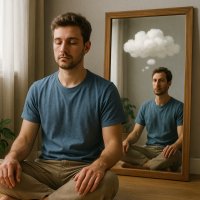 A Practical Guide to Thought-Awareness. You can spend your life inside the stories of your mind without ever learning how to see your thoughts clearly and objectively. Most of the stuff we tell oursel…
A Practical Guide to Thought-Awareness. You can spend your life inside the stories of your mind without ever learning how to see your thoughts clearly and objectively. Most of the stuff we tell oursel…The Collison Decision Matrix - A Simple Framework for Better Choices
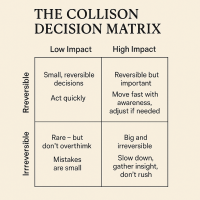 The Collison Decision Matrix Is A Practical Everyday Thinking Tool. Most of us spend a surprising amount of time worrying about decisions. From small ones such as what to wear, what to eat, what to te…
The Collison Decision Matrix Is A Practical Everyday Thinking Tool. Most of us spend a surprising amount of time worrying about decisions. From small ones such as what to wear, what to eat, what to te…The Power Of Asking The Right Question
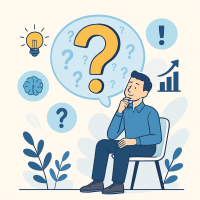 The Power Of Asking The Right Question Lies In The Quest For Insight. To experience the power of asking the right question you must develop the practice of asking questions. The best way to improve th…
The Power Of Asking The Right Question Lies In The Quest For Insight. To experience the power of asking the right question you must develop the practice of asking questions. The best way to improve th…Site Pathways
 Here is a site pathway to help new readers of Zen-Tools navigate the material on this site. Each pathway is based around one of the many key themes covered on this site and contain a 150 word introduc…
Here is a site pathway to help new readers of Zen-Tools navigate the material on this site. Each pathway is based around one of the many key themes covered on this site and contain a 150 word introduc…How To Live With Contradiction - Beyond Thought Let Stillness Speak
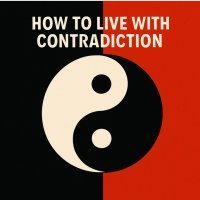 A major impact on so many peoples' lives is the situational contradiction of unfilled realistic expectations. So where does all this leave us? Well here we are, with mental equipment that is more lim…
A major impact on so many peoples' lives is the situational contradiction of unfilled realistic expectations. So where does all this leave us? Well here we are, with mental equipment that is more lim…How To Trust The Process Of Mindfulness - Right Now
 In mindfulness, the process isn’t some distant goal — it's what is happening right now. When we talk about how to trust the process of mindfulness the credibility of the process is heavily dependent…
In mindfulness, the process isn’t some distant goal — it's what is happening right now. When we talk about how to trust the process of mindfulness the credibility of the process is heavily dependent…Inner Mastery For Outer Impact - Mental Clarity For Effective Action
 Insights only matter if they translate into consistent action. In a world crowded with quick fixes and motivational soundbites, the theme “Inner Mastery for Outer Impact” calls us to something more e…
Insights only matter if they translate into consistent action. In a world crowded with quick fixes and motivational soundbites, the theme “Inner Mastery for Outer Impact” calls us to something more e…The Wise Advocate - Helping You Achieve The Very Best Outcome
 The focus of your attention in critical moments of choice either builds or restricts your capacity for achieving the best outcome. When we talk of 'The Wise Advocate' its easy to think of the consigl…
The focus of your attention in critical moments of choice either builds or restricts your capacity for achieving the best outcome. When we talk of 'The Wise Advocate' its easy to think of the consigl…Trust The Process - Beyond The Cliche
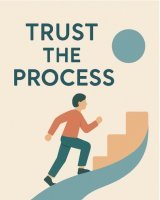 The phrase "trust the process" has become a cliche, the woo-woo mantra of the "self help" industry. Those three little words feel like they ought to mean something useful but hidden behind them are a…
The phrase "trust the process" has become a cliche, the woo-woo mantra of the "self help" industry. Those three little words feel like they ought to mean something useful but hidden behind them are a…The Dopamine Delusion - Why Anticipation Beats Achievement
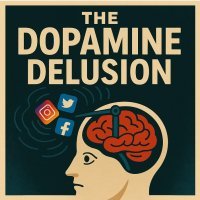 The thrill we feel is not in the having, but in the wanting. The more we have, the more we want. The more things we acquire and the easier things get for us, the more discontent we feel. The more spo…
The thrill we feel is not in the having, but in the wanting. The more we have, the more we want. The more things we acquire and the easier things get for us, the more discontent we feel. The more spo…The Power Of Silence Is Experienced In Your Use Of Language
 Practise the "Beneficial Neurological Delay" for optimal comprehension. The power of silence is experienced in your use of language, specifically: - How you formulate the words you use to think and in…
Practise the "Beneficial Neurological Delay" for optimal comprehension. The power of silence is experienced in your use of language, specifically: - How you formulate the words you use to think and in…
